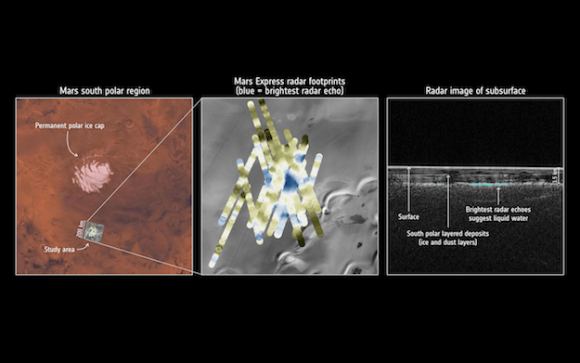One of the hardest things to reconcile in science is when new data either complicates or refutes previously findings. It’s even more difficult when those findings were widely publicized and heralded around the community. But that is how science works – the theories must fit the data. So when a team from JPL analyzed data from Mars Express about the Martian South Pole, they realized the findings announced in 2018 about subsurface lakes on Mars might have been more fraught than they had originally thought.
That original discovery was announced after scientists found particularly bright spots in radar signals under the surface that were interpreted as being from liquid water. Located in the region called the “South Polar Layered Deposits”, layers of water, dry ice, and dust have been intermixed over millions of years as Mars’ axial tilt changed. In lower layers, temperatures were high enough that sufficiently salty water could potentially be liquid.
When looking over data from the entirety of the Martian south pole, the JPL scientists noticed the same highly reflective surface in dozens of additional places under the surface. Some appeared to be within 1.6 km (1 mile) of the surface. Unfortunately, that also means the temperature would be a chilly -63 C (-81 F). Even with a massive amount of perchlorates (a special kind of salt prevalent on Mars), water would still be frozen at those temperatures.
First, the investigators, Jeffrey Plaut and Aditya Khuller from JPL (Khuller is now at ASU), tried to think of other potential heat sources that could increase the temperature in the areas they saw the highly reflective features. An obvious candidate would be volcanism, which is potentially responsible for undersea oceans on other worlds in the solar system. However, there is no other evidence of active volcanism at the south pole, so the researchers ruled it out as a heat source.

Credit – Context map: NASA/Viking; THEMIS background: NASA/JPL-Caltech/Arizona State University; MARSIS data: ESA/NASA/JPL/ASI/Univ. Rome; R. Orosei et al 2018
Lacking enough heat to create liquid water, the researchers also don’t know what could potentially be causing these highly reflective surfaces. Could they be lakes caused by heat provided by some unknown source? Is there some other material that is as reflective to radar as liquid water underneath Mars’ surface? The details of a future manned mission to the Red Planet might literally hinge on the answer to those questions. But for now, there is no satisfactory answer.
Simply put, either there are dozens of subsurface lakes on Mars that are being heated by an as yet unknown source, or there could be some unknown material that reflects radar waves as effectively as liquid water that tricked scientists into thinking liquid water is present there. Or it could be some combination of the two, with liquid water being present in some warmer pockets while the unknown material is present in colder regions. According to other research just reported on by UT, there are multiple possibilities in between.

Credit – ESA / NASA / JPL-Caltech
Given water’s importance to the success of any human presence on Mars, explorers are going to want to know where on that spectrum the truth lies. And the only way to find out is to collect yet more data. Let’s hope whatever data is collected answers more questions than it brings up next time.
Learn More –
JPL – Study Looks More Closely at Mars’ Underground Water Signals
UT – Unfortunately, There are Other Viable Explanations for the Subsurface Lakes on Mars
Phys.org – ‘Lakes’ under Mars’ south pole: A muddy picture?
Geophysical Research Letters – Characteristics of the Basal Interface of the Martian South Polar Layered Deposits
Lead Image –
Ice cap on Mars’ south pole that contains frozen water as well as dry ice.
Credit – ESA / DLR / FU Berlin / Bill Dunford

